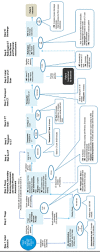Emergency Department Time Course for Mild Traumatic Brain Injury Workup
- PMID: 30013697
- PMCID: PMC6040897
- DOI: 10.5811/westjem.2018.5.37293
Emergency Department Time Course for Mild Traumatic Brain Injury Workup
Abstract
Introduction: Mild traumatic brain injury (mTBI) is a common cause for visits to the emergency department (ED). The actual time required for an ED workup of a patient with mTBI in the United States is not well known. National emergency medicine organizations have recommended reducing unnecessary testing, including head computed tomography (CT) for these patients.10.
Methods: To examine this issue, we developed a care map that included each step of evaluation of mTBI (Glasgow Coma Scale Score 13-15) - from initial presentation to the ED to discharge. Time spent at each step was estimated by a panel of United States emergency physicians and nurses. We subsequently validated time estimates using retrospectively collected, real-time data at two EDs. Length of stay (LOS) time differences between admission and discharged patients were calculated for patients being evaluated for mTBI.
Results: Evaluation for mTBI was estimated at 401 minutes (6.6 hours) in EDs. Time related to head CT comprised about one-half of the total LOS. Real-time data from two sites corroborated the estimate of median time difference between ED admission and discharge, at 6.3 hours for mTBI.
Conclusion: Limiting use of head CT as part of the workup of mTBI to more serious cases may reduce time spent in the ED and potentially improve overall ED throughput.
Conflict of interest statement
Conflicts of Interest: By the WestJEM article submission agreement, all authors are required to disclose all affiliations, funding sources and financial or management relationships that could be perceived as potential sources of bias. This work was funded by BrainScope, Inc., Bethesda, Maryland, USA. Facilitation of meetings, the conduct of the analyses, and manuscript development support was provided by Evidera, Inc. Data from the second part of this study was a cohort derived from a study funded in part by a research contract from the U.S Army, contract #W81XWH-14-C-1405. Disclaimer: The views, opinions and/or findings contained in this report are those of the author(s) and should not be construed as an official Department of the Army position, policy or decision.
Figures
References
-
- Centers for Disease Control and Prevention Web Site. Traumatic brain injury in the United States: Fact sheet. [Accessed July 28, 2015]. Available at: http://www.cdc.gov/traumaticbraininjury.
-
- Marin JR, Weaver MD, Yealy DM, et al. Trends in visits for traumatic brain injury to emergency departments in the United States. JAMA. 2014;311(18):1917–9. - PubMed
-
- Barbosa RR, Jawa R, Watters JM, et al. Evaluation and management of mild traumatic brain injury: an Eastern Association for the Surgery of Trauma practice management guideline. J Trauma Acute Care Surg. 2012;73(5 Suppl 4):S307–14. - PubMed
-
- Jagoda AS, Bazarian JJ, Bruns JJ, et al. Clinical policy: neuroimaging and decision making in adult mild traumatic brain injury in the acute setting. Ann Emerg Med. 2008;52(6):714–48. - PubMed
MeSH terms
LinkOut - more resources
Full Text Sources
Other Literature Sources
Medical

